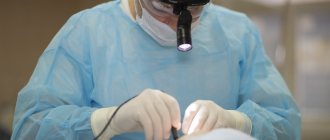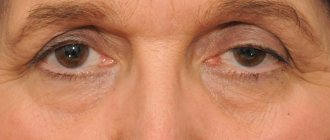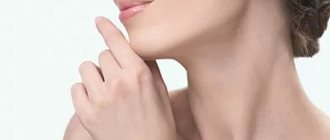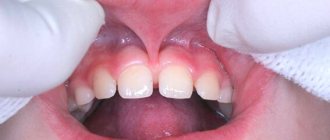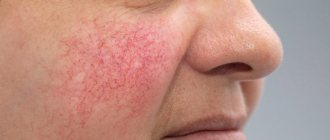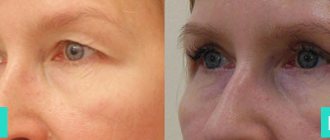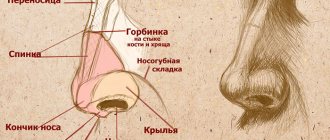If you want a beautiful nose, rhinoplasty!
Perfect proportions are rare by nature, so often the beauty and aesthetics of the face are hampered by a nose that is too large or small, too wide or narrow, crooked or flattened.
Sometimes rhinoplasty is due to medical reasons - for example, if a deviated septum resulting from an injury makes breathing difficult and leads to discomfort.
Rhinoplasty allows you to:
- adjust its shape,
- lengthen it or shorten it,
- adjust the tip of the nose, the shape and size of the nostrils,
- remove the hump, as well as cope with other imperfections.
Important! Initially, every patient must understand that rhinoplasty is a complex operation, the results of which, on the one hand, should not disrupt the normal physiology of the nose, and on the other hand, cannot exceed a certain limit determined by its anatomical structure.
Preparing for surgery
To prepare for surgery, it is necessary to undergo tests, examine the nasal septum, and intranasal pressure. The doctor conducts a consultation, identifies the specifics of the problem, and finds out the patient’s wishes.
At the end of the examination, the stage of modeling the future shape of the nose begins. The doctor and patient must jointly choose the optimal model of the nose shape. The doctor takes into account all the structural features of the patient’s nose and the best preservation of its functions, and it is important for the patient to evaluate the model so that after the operation the nose emphasizes the attractiveness of the face and the result brings pleasure.
Plasma therapy in gynecology.
Plasmolifting is an innovative, non-surgical method of restoration and rejuvenation of the body, based on the introduction of platelet-enriched plasma to the patient.
Plasmolifting in gynecology is used to accelerate tissue restoration during anti-inflammatory therapy.
Indications for the procedure:
- For inflammation of the pelvic organs (endocercevitis, chronic salpingoophoritis);
- During adhesions;
- For dystrophic diseases (leukoplakia of the cervix, kraurosis of the vulva);
- For cervical erosion;
- In pregravid preparation for pregnancy (especially if there is a history of frozen pregnancies or abortions);
- For discomfort in intimate life after childbirth or as a result of other reasons;
- During menopause (dryness, urinary incontinence, anorgasmia).
Advantages:
- This is one of the safest procedures in modern medicine;
- There are no allergic reactions or side effects, since the patient’s own blood is used (with the exception of a reaction to heparin contained in a test tube);
- Plasma injections are atraumatic and painless;
- The effect is observed immediately after the first procedures;
- After plasma lifting procedures, tissues are restored very quickly, blood flow and metabolism in cells improve, the elasticity of intimate muscles increases, inflammation stops;
- As a result of plasma lifting, the body’s immune defense is restored and a cure occurs.
Contraindications for use:
- Pregnancy and lactation;
- Malignant tumors;
- Acute infections;
- Systemic blood diseases;
- Heparin intolerance;
- Predisposition to the formation of hypertrophic scars;
- Mental illnesses.
Plasmolifting is a course procedure. The course begins in the first half of the menstrual cycle. 5–7 procedures are required with a break of 5–7 days, depending on the patient’s health condition and the expected result.
To carry out the procedure, make an appointment with a gynecologist.
Operation
Rhinoplasty can last from 30 minutes to 3 hours. Most often it is performed under general anesthesia, because... because it is completely safe for the patient and does not leave any memories of the operation.
Operations are performed closed or open. Closed ones are performed inside the nasal cavity, under the wings. In open surgery, a small incision is made in the columella, the front part of the nasal septum. The recovery period for closed surgeries is usually shorter.
Rhinoplasty (nose job)
Aesthetic rhinoplasty (nose job) is a plastic surgery aimed at changing the shape and/or size of the external nose. Its task is to create a new harmonious appearance, while maintaining individual characteristic facial features.
The most suitable age for performing aesthetic rhinoplasty is the period from 20 to 35-40 years, however, in some cases, the operation can be performed at any age.
Rhinoplasty is a surgical procedure and is performed under general anesthesia in combination with local anesthesia. In this regard, the patient must undergo a comprehensive examination, including clinical and laboratory examination and consultation with specialists (ENT, therapist, anesthesiologist). To successfully perform the operation and prevent complications, patients must warn the doctor about the presence of chronic and acute diseases at the time of the proposed operation, past illnesses, possible allergic reactions to medications, etc. In case of deviations in the results of clinical and laboratory examinations, contraindications to surgical intervention identified by specialists, as well as discrepancies between the patient’s requirements and the expected result, the operation may be refused.
The technique of plastic surgery for rhinoplasty depends on the tasks facing the surgeon and the existing conditions. The essence of the intervention is to correct the bone and cartilage structures that form the skeleton of the nose. There are two methods for performing this operation: with an external incision on the skin of the nasal septum (“open” rhinoplasty) and using only intranasal incisions (“closed” method). With the “closed” method of surgery, there is one small incision in each nostril, which are not visible from the outside and after some time are difficult to distinguish even during a medical examination. After “open” rhinoplasty, a scar remains on the skin of the nasal septum, which is normally barely noticeable. In addition, additional skin incisions are sometimes used at the base of the nostrils. Scars from these incisions are usually almost invisible. Both methods provide good results.
The duration of rhinoplasty surgery is strictly individual, and usually lasts 2-3 hours. After rhinoplasty, a fixing bandage and intranasal tampons are used for several days.
Rhinoplasty, like any surgical intervention, is accompanied by natural changes in the correction areas. There may be minor pain on the first day. Bruises under the eyes last up to 10-14 days. In the first days, swelling of the nose is usually observed, both visible, externally and internally, which may manifest itself as nasal congestion. Slight swelling of the tissues of the external nose can persist for up to 3-4 months, which is usually not noticeable to others. The bridge and tip of the nose may temporarily have decreased sensation. The processes of tissue formation and restructuring after rhinoplasty, as a rule, last up to 6-8 months, in some cases up to 1 year. It is generally accepted that the final result of a nose job can be assessed no earlier than this time.
The time frame for restoring a normal level of social activity depends on individual characteristics and the extent of the rhinoplasty surgery performed. Most patients can return to work 4-5 days after surgery. However, during the first months there may be some restrictions on diet, significant physical activity, sexual intercourse, smoking and certain activities. It is not recommended to wear heavy-framed glasses for 5-8 weeks after surgery.
Since each rhinoplasty operation requires careful individual planning, any questions that arise related to the upcoming operation must be discussed during a consultation.
Rehabilitation period
After the operation, the patient is usually in the hospital, under the supervision of doctors, for two days. After rhinoplasty, you are prescribed to wear a special butterfly bandage for 10-14 days. Swelling goes away in 2-3 days. After 7 days, the nose acquires an aesthetically acceptable appearance. Full recovery takes no more than six months.
Rehabilitation after rhinoplasty
When working with the cartilage and bone structures of the nose, it is impossible to completely avoid bruising and swelling, but after 2 weeks you can return to normal life. As a rule, there is no pain after rhinoplasty, but if it suddenly appears, it can be easily relieved with simple painkillers.
After the operation, the patient is in the hospital, a bandage is applied, which restrains swelling and shapes the nose for a week. After 7-10 days, the bandage is removed. After removing the plaster cast, swelling will appear, and difficulty breathing may occur due to swelling of the mucous membrane inside the nose. The swelling will go down in 2-3 days, and breathing will be restored. After 7 days, the nose acquires an aesthetically acceptable appearance. Full recovery takes no more than six months.
Why are our doctors and diagnostics better than others?
- The doctor is certified and trained in Moscow by the best specialists in the field of gynecology!
- The doctor’s knowledge and vast experience make it possible to achieve amazing success in the treatment of diseases of the female reproductive system;
- The IzhMedGroup Clinic has modern diagnostic equipment that allows you to make an accurate diagnosis and begin treatment;
- Location in the very center of Izhevsk, within walking distance to any public transport;
- Own parking;
- Attractive prices;
- Convenient time to visit a doctor.
Why do they resort to rhinoplasty?
- deviated septum
- impaired breathing
- hump
- disproportionately large nostrils
- long, too big or small nose
- "dangling" drooping tip
Restrictions
After rhinoplasty it is prohibited:
- remove tampons yourself;
- sleep on the nose;
- visit the pool for 2 months;
- heavy physical activity;
- severe nose blowing for 2 months;
- remove, move, adjust the bandage;
- pull out and trim threads;
- do any cosmetic procedures on the skin of the nose for 3 months.
Complications
Complications after rhinoplasty are rare. In theory, there may be breathing problems, pus, or bleeding. But if you follow all the recommendations, the recovery will take place without problems.
“Myths” about rhinoplasty
“Rhinoplasty can give you any size and shape”
There are certain limitations associated with the characteristics of both the bone structure and soft tissues: each patient has their own. In addition, it does not always make sense to change your nose beyond recognition, since the aesthetic result depends not only on the shape and size, but also on how harmoniously it looks on your face.
“Nose job is painful”
For this operation, general anesthesia is most often used so that patients do not feel pain or discomfort. Any discomfort in the first days of the rehabilitation period can be neutralized with painkillers, but the real need for this arises in no more than 6% of cases.
“Plasty does not leave scars”
This is not entirely true: when performing rhinoplasty with an open approach, a W-shaped incision mark will remain in the middle of the columella, but don’t worry - after a few months it becomes barely noticeable, and after a year it is almost impossible to find it even for the patient himself.
“The nose will look unnatural”
To carry out this type of operation, you definitely need a consultation, where, taking into account the characteristics of your appearance, we will determine the shape and profile of the new nose so that it looks natural. With a high-quality operation, no one will even notice that there was a surgical intervention.
“Special care of the nose is required after surgery”
Of course, in the first time after surgery, the nose does require special careful care and remains quite vulnerable, but in the future no problems arise with it. Some experts believe that the nose even becomes stronger due to the formation of bone calluses.
Rhinoplasty in Saratov, performed using the latest methods, at the level of world standards, is real! Candidate of Medical Sciences, plastic surgeon, E.A. Dobreikin invites you to make an appointment!
Expand
Thread perineolifting
Thread perineolifting is a minimally invasive surgical procedure for tightening and connecting damaged perineal muscles using special threads (has a patent, as well as a patent for the placement technique).
Today this is one of the most effective ways to solve aesthetic or medical issues related to the condition of the genital organs.
The indications are:
- Deformation of the perineum, pelvic floor muscles;
- Postpartum problems;
- Gaping of the genital slit;
- Discomfort during sexual activity;
- Increased frequency of infectious lesions of the vulva;
- Prolapse of the genital organs.
Advantages of minimally invasive perineoplasty with threads and results:
- Aesthetic and functional improvement;
- Prevention of genital prolapse;
- Minimally invasive technology;
- Local anesthesia;
- Fast recovery period;
- The resorption period of the thread is from 180 to 210 days;
- The thread creates a fibrous reaction, which leads to the formation of a directed connective tissue frame of the perineum, which, in addition to mechanical support, provides the so-called “secondary traction vector”, which remains even after complete resorption of the thread.
- The effect of fibrosis remains for a long time.
The procedure is performed by a certified specialist with extensive experience in gynecology.
The result can be assessed immediately after the procedure.
Lifting using this method is a new quality of life for a woman, increasing self-confidence and, of course, health!
To carry out the procedure, make an appointment with a gynecologist
